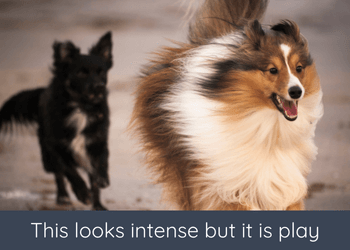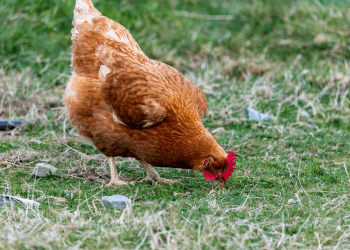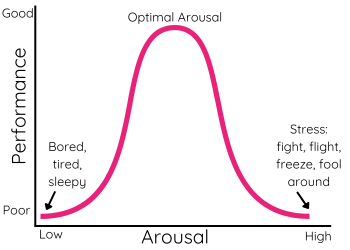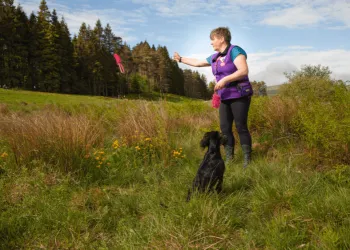The problem with all of that is that there is no scientific evidence that predatory drift exists. And - if that’s the case - are dog experts creating a boogeyman to terrify you that your high prey drive dog has an unpredictable monster within them?

Predatory drift is an interesting concept and is often described in ways that are frightening. It is described as an out of the blue and often fatal attack by one dog or a group of dogs on another dog. Common advice is to be concerned about any dog with a prey drive and to ensure that predatory drift doesn’t become an issue by ensuring that those dogs are never permitted be loose around small dogs.
I have witnessed a small number of incidents where a larger dog has suddenly attacked and injured a smaller dog. Often the dogs were fine together before the attack. The attacks looked predatory for sure. The larger dog was locked on with their eyes and went straight on the attack. These are horrible things to witness and I completely understand why so many training and behaviour practitioners see them as predatory and advise taking drastic action to prevent them happening again.
The problem with all of that is that there is no scientific evidence that predatory drift exists. And - if that’s the case - are dog experts creating a boogeyman to terrify you that your high prey drive dog has an unpredictable monster within them?

Predatory drift is a concept that has arisen from within the dog training and behaviour industry and is most often attributed to Ian Dunbar or Jean Donaldson. Neither of them has cited any evidence for its existence – or at least no evidence that I can find.
The risk factors for predatory drift are often said to be:
1. A substantial size difference between the dogs.
2. A group of three or more dogs because that allows for multiple dogs to gang up on one dog.
3. A dog in the group looking and behaving like prey by running fast, screaming in fear if they are chased and being small.
4. A dog in the group who is a ‘known finisher’. A ‘known finisher’ is a dog with a high prey drive who has been known to kill prey animals like rabbits or squirrels.
That description, for sure, makes it sound as if the dogs who attack in those sorts of situations are behaving in a predatory way, but it is wise to dig more deeply. Decades of research into animal behaviour gives information that is more accurate – and useful - in avoiding having a traumatic incident with your dog.
If you’d like to learn more about prey drive in dogs, you can read more about it here.
The idea for predatory drift is thought to have come into the dog training industry from a famous paper written in the 1960s by Keller and Marian Breland titled The misbehavior of organisms. The Brelands are famous for running a business where they trained animals for entertainment and adverts. At first, they felt as if training animals was a simple process of using the best rewards for the animal and delivering them correctly. They felt as if they could train any animal to do anything that the animal was physically able to do.
After a while what they started to find with some of the animals was that the training didn’t work. The animals would seem to drift into instinctive foraging. Raccoons would repeatedly ‘wash’ the items they were meant to be putting into a container. The pigs who were being trained to pick up large wooden coins and then deposit them into a huge piggy bank started to root at the coins instead of lifting them. Chickens being trained to stand on a platform for about 15 seconds started to peck at the platform instead.
The animals would persist in these instinctive actions even if it meant that they did not get to eat at all. The conclusion was that instinctive patterns linked to getting food are so strong in animals that they can easily appear in unexpected ways.

For anybody who has read the paper and who has also witnessed or heard about an out of the blue attack between dogs who are friends that resulted in serious injury or death of one of the dogs, it seems obvious that dogs sometimes drift into instinctive food gathering behaviour in unexpected ways. For dogs, that means drifting into predatory behaviour which is where the idea for predatory drift is said to have come.
However, a behaviour scientist named William Timberlake had a different take on what was going on. He pointed out that the persistent rooting, washing or pecking always happened at the same point in training. It happened when the length of time between the animal performing a trained action and getting food was lengthened.
To him, the time was the issue. During training, the animals were always in the presence of food and were actively trying to get more food. So, if the trainers made an error and the time between action and food was too long, the animal would move into instinctive patterns aimed at finding and catching food.
Animals all take different times to learn things and some individuals were being moved on too quickly which resulted in what looked like them drifting into instinctive food getting actions. Actually, what was happening was the animal was just changing their approach because they didn’t understand the what they were being asked to do.
Accounts of what is called predatory drift are nothing like that. Food plays no part in them. They are described as the dogs playing or being loose with each other and then an ‘out of the blue’ attack.
It makes sense then to look at what play between dogs is like. Play is said to have five main features:
It is voluntary
It is fun
It is self-rewarding
It is different from more serious pursuits
It starts in safe situations
In play dogs often act in ways that mimic more serious pursuits like predation, mating and aggression. In dogs, chasing, biting and capturing are common parts of play as are mounting behaviour, teeth baring, pinning down, growling and snarling. When dogs are playing, bites will be inhibited, play signals such as bows will be seen. Dogs often take breaks from play where they will pause briefly.
Dogs play for a number of reasons. It is an important part of both social and physical development for dogs. It helps dogs to deal with meeting new dogs and maintaining strong bonds with dogs they know well. It is even said that play is important for brain growth and helps to rewire the brain.

Research into play notes that when playing together, dogs are able to modify the way they play to enable them to have games with many different play partners. Even so, difficulties between dogs can arise because dogs come in so many different shapes, sizes and coats making communication hard for some dogs. Different breeds often have different play styles as well. They range from prolonged sessions of fast, active chasing, barging and biting to dogs who briefly run next to each other and then go around sniffing together.
Predatory patterns can be seen in play with some dogs intensely stalking potential play partners, some chase and others body slam or grab at backs of necks. This is not an exhaustive list and there are other common play behaviours that I haven’t listed here.
Of interest here, researchers noted that it was only when dogs were playing alone with a toy where play seemed to be related to predatory behaviour. When playing with other dogs, the structure of the play sessions and motivation behind them was about play rather than predation.
The key thing to note here is that sometimes play looks like but isn’t predation. Since dogs playing together is such a common factor in incidents reported as predatory drift, could something else be going on?
Yes! Many things could be going on but arousal will be playing a part. I’ll start this section by saying that arousal is necessary for any of us to get anything done. Arousal is the psychological and physiological state of being aware of the world around you. You need to be aroused to be awake, able to pay attention, able to act and able to process information from the world around you. Dogs are exactly the same.
Higher levels of arousal allow you to filter out pieces of information that are not important for whatever you are doing. Have a watch of this video and see if you can focus enough to see what’s really going on.
If your browser doesn’t show you the video, you can click here to watch it.
Wasn’t that fascinating?
Did you see the bear or were you too focused on watching the ball passes? The first time I saw this video, I did not see the bear. Being in a state of arousal is what allows you to filter everything else out to focus on who is passing the ball – even something as obvious as somebody in a bear suit moonwalking through the middle of the players.
When dogs are playing, their arousal will be higher than it would be if they are just lying resting. That higher arousal will allow them to focus on the complexities of play. If you’ve ever watched dogs play together, they are often moving fast, they will be using their teeth and they have a variety of ways of checking in with each other that what is going on is still play. Getting it right requires the dogs to be at an optimal level of arousal.
The impact that arousal has on a dog’s ability to perform well at something – like playing! – is often described by the Yerkes-Dodson law. It isn’t new – the psychologists who developed it did so in the early 1900s. It can be thought of as an inverted U-shaped curve. Initially, if arousal increases, performance improves BUT if arousal continues to increase, performance will get poorer.
Poor performance in play looks like dogs who bite too hard and who don’t listen to the signals their playmates give them. They may barge unwilling dogs off their feet or chase a dog who is frightened of them and ignore the signs of fear. In short, arousal that is too high may cause the dog to act in ways that might look predatory BUT are not.
At the highest levels arousal is stressful. Stress is important to pay attention to because it triggers a number of responses as animals – including humans – try to deal with it. The common stress responses are known as the four Fs which stand for fight, flight, freeze and fool around. Fight and flight in particular will cause the sort of reactions that are often labelled as predatory drift.
Arousal rising does not happen out of the blue. You can learn to spot it happening and take steps to keep your dog safe.

The age of dogs is important as well in how risky play between dogs is.
When playing well dogs have a lot of control over themselves. To keep the game going they have to remember to inhibit the force of their bite so that they don’t hurt their playmate and put them off. They have to check in with the other dog to make sure that it is still play. They have to do it in a fast paced constantly changing situation as well.
The time of life when dogs struggle most with that sort of control is the time of life when they are most interested in playing with other dogs – adolescence. If you weren’t aware before, now you know that our dogs go through a time that is similar to that of human teenagers.
Here are some features of teenage dogs:
Less obedient to known commands or cues
More interested in running off to play with other dogs
If they are going to have a high prey drive, it often appears at this time of life
Willing to engage in risky behaviour like approaching strangers or getting into conflict with other dogs
Dogs will typically enter adolescence at around 5 – 6 months and be out of it again by around 18 months – 2 years. In some breeds, it commonly ends later than 2 years and in some breeds, it commonly starts under 5 months. Within breeds as well there is a huge variation. Some dogs sail through it and you really wouldn’t know anything was going on while others change dramatically and become hard to live with throughout much of adolescence.
The reason for the difficulties is that young dogs are going through huge hormonal and neurological changes that are necessary to turn them into adult dogs. Key when talking about risks in play with other dogs is understanding that the part of the brain that allows dogs to control themselves isn’t developed until late in adolescence.

There is a perfect storm type situation with adolescent dogs. Many adult dogs will not play with them and in fact it is common for adolescent dogs to be repeatedly snapped and snarled at just for approaching adult dogs. When out on walks and meeting new dogs, often the only dogs who’ll play with adolescent dogs are other adolescent dogs.
If play continues until the dogs are highly aroused and one of the dogs becomes aroused enough to develop a fight or flight stress response then it’s more likely that in a group of adolescents, the other dogs won’t be able to control themselves enough to prevent the situation from becoming more serious. With the lack of ability to control things like force of bite and if there is a big size difference between the dogs, the risk of serious injury or death is higher in those situations. That risk has nothing to do with prey drive and everything to do with arousal and life stage.
The final thing to look at when considering if predatory drift exists or not is a well-known framework that is used to understand behaviour. Applying it to predatory drift reveals some interesting answers. The framework consists of 4 questions:
If it exists, the causes would be the risk factors and those just don’t match at all with typical causes of predatory behaviour. Predation is almost always triggered in dogs by them being aware of prey or the possibility that prey might be around. Dogs simply don’t engage in social play with prey so if play is going on, predation isn’t part of it. No matter what it looks like.
Predation on animals that are going to be eaten is useful for the survival of some dogs and was useful for the survival of the animals that dogs are descended from. However, in a social species like dogs, survival is not helped by the risk that social interactions will suddenly become deadly attacks.
Similarly to the above, I can’t imagine an evolutionary reason for predatory drift. In social species like dogs, what has evolved is the ability to deal with conflict with little or no injuries to either dog in the conflict. The reason for that is that a group stands a better chance of thriving if its members aren’t injuring or killing each other.
This question would explore how predatory drift starts and changes throughout a dog’s life, influenced by its experiences and learning. However, since it is said to be something that happens suddenly and with no warning, it is hard to see how it could develop in individual dogs.
Tinbergen’s framework is not much help for you if you do have a dog with a prey drive but not to worry. I have a free course you can sign up for today that will give you tons of help and support.
As I’ve outlined above, there are good reasons to be careful about play between dogs in some situations. Here is some advice about keeping play fun and all the dogs safe:
Be aware of the age of dogs playing together. If you have more than one adolescent, make sure they take breaks to calm down.
Get to know dog body language well enough that you can spot the signs of arousal rising and know your dog well enough to understand when a break is needed.
Practice being able to call your dog away from play and encourage dogs to calm down when play is becoming intense.
Be aware that if there is a big size difference, the smaller dog is vulnerable. A play bite that is harder than normal or not placed accurately due to high levels of arousal is much riskier with a smaller dog.
Even if both dogs are friendly and playful consider if they are dogs who will be able to play well together and if not, take them on a nice walk together on longer leads and encourage them to enjoy walking together. Many dogs love sharing a walk with a friend without any playing happening at all.
If your dog goes out in a group with a dog walker, make sure that the dog walker understands when they need to calm things down and how to keep all the dogs safe.
If your dog has a high prey drive, there is no need to worry that they will suddenly ‘drift’ into predatory behaviour when they are playing with their dog friends. There is no evidence that it ever happens. There is plenty of evidence that a much more likely explanation is high arousal play that went on for too long between dogs who are not able to regulate their own arousal levels to keep the play safe and fun.
Given the number of different shapes, sizes and preferences of dogs that exist, it is wise to be aware and paying attention when your dog is playing with another dog especially if the dogs don’t know each other well, there is a big size difference between the dogs or if one of the dogs is highly aroused.
Play between dogs absolutely can go wrong but dogs are NOT ‘drifting’ into predation.
References:
Beckoff, M. (2018) Why Dogs Do What They Do. Chicago: The University of Chicago Press
Bradshaw, J.W., Pullen, A.J. and Rooney, N.J., 2015. Why do adult dogs ‘play’?. Behavioural processes, 110, pp.82-87. DOI: https://doi.org/10.1016/j.beproc.2014.09.023
Breland, K. and Breland, M., 1961. The misbehavior of organisms. American psychologist, 16(11), p.681. DOI: https://doi.org/10.1037/h0040090
Jean Donaldson (2006) Preparedness, Predation and Predatory Drift. [DVD]

Would you like to be in the know?
Join my mailing list, get my monthly newsletter and be kept up to date about special offers via email.

I am the founder of Best Dog Learning and Stuff and a massive prey drive enthusiast. I've lived with high prey drive dogs for over 20 years and I love them. I run the awesome High Prey Drive Club where I help my members learn to have fabulous walks and happy lives with their high prey drive dogs.
I am a published researcher in my field with both my original research and my review of the literature looking at prey drive in dogs being published in the respected journal Applied Animal Behaviour Science.
I am the author of Canine aggression: Rehabilitating an aggressive dog with kindess and compassion.
I want to show you how easy and fun it can be to have a high prey drive dog.
If you'd like help with your dog, I'm ready to help you right now.